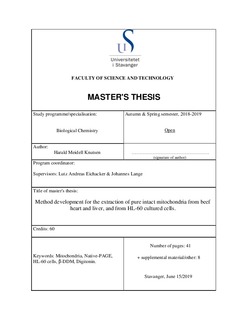| dc.contributor.advisor | Eichacker, Lutz Andreas | |
| dc.contributor.advisor | Lange, Johannes | |
| dc.contributor.author | Knutsen, Harald Meidell | |
| dc.date.accessioned | 2019-10-22T13:03:11Z | |
| dc.date.available | 2019-10-22T13:03:11Z | |
| dc.date.issued | 2019-06 | |
| dc.identifier.uri | http://hdl.handle.net/11250/2623759 | |
| dc.description | Master's thesis in Biological chemistry | nb_NO |
| dc.description.abstract | Mitochondria have an essential role in the preservation of life. Life persists as a result of structure and energy, and the mitochondria are key components of energy production. Mitochondrial dysfunction is considered a characteristic cause of aging, as well as an involved factor in almost all chronic diseases. This makes it important to perform studies on the mitochondria to better understand mutational mechanisms that occur and the consequences they bring, and in the end develop appropriate treatments to prevent such outcomes. When performing such research, a common path is to procure isolate metabolically active mitochondria. When doing so, purity of sample is key to uncover the “true” nature of mitochondrial activity in controlled conditions. In this thesis, the objective was to develop a method of obtaining such a purified sample of intact mitochondria. Mitochondrial extracts have been performed on beef heart and liver, as well as on the human myeloblastic suspension cell line HL-60. Although progression was made, by the end of the practice a pure mitochondrial extraction was yet to be accomplished. Extractions made on beef heart seemed to be most promising, with clear concentrated protein complex bands observed from NativePAGE. However, the samples were contaminated and before any methodical alterations could be made the availability of beef heart became scarce. Mitochondrial extraction from beef liver seemed most troublesome. After performing an additional purification with a percoll gradient, the sample did not seem to provide any protein complexes in the subsequent Native-PAGE that was performed. The mitochondrial extraction from HL-60 cells also proved challenging. However, progress seemed to be made in the effort to solve to issue of resuspending the pellet after lysing the cells with digitonin. | nb_NO |
| dc.language.iso | eng | nb_NO |
| dc.publisher | University of Stavanger, Norway | nb_NO |
| dc.relation.ispartofseries | Masteroppgave/UIS-TN-IKBM/2019; | |
| dc.subject | biological chemistry | nb_NO |
| dc.subject | biochemistry | nb_NO |
| dc.subject | biokjemi | nb_NO |
| dc.subject | biologisk kjemi | nb_NO |
| dc.subject | mitochondria | nb_NO |
| dc.title | Method development for the extraction of pure intact mitochondria from beef heart and liver, and from HL-60 cultured cells. | nb_NO |
| dc.type | Master thesis | nb_NO |
| dc.subject.nsi | VDP::Mathematics and natural science: 400::Basic biosciences: 470::Biochemistry: 476 | nb_NO |
